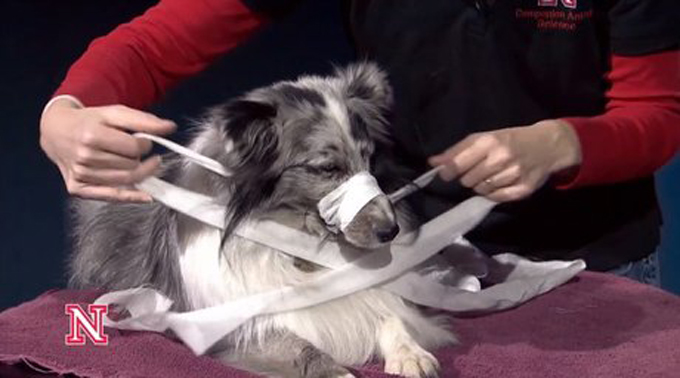
There are many instances in which you may need to create a makeshift muzzle for your pup. If your dog has been injured and wants to chew at the injury, if your dog is acting aggressive and you do not have a muzzle on you, you will need to be able to fashion a muzzle in a pinch. Also, you could come across an injured dog you don’t know and want to muzzle them to be safe while you treat injuries and get them to a vet. Luckily, there is a simple way to make a muzzle out of gauze and other fabrics for situations like this.
1. Approach the dog in a calm, soothing manner.
Instinct may lead us to jump our dog if they suddenly become aggressive or injured. This, however, is the wrong way to go about muzzling a dog. You need to remember that your dog is agitated, scared, in pain, or a combination of these things, and they are looking to you, their alpha, on how to act. Speak to your pup in a soothing voice and approach them slowly.
2. Lay the dog down in a comfortable position.
Do not hold your dog down with excessive force because this could stress them out more than they already are. You’re going to want to get your dog in a comfortable position in which you can also have access to their snout. For a small dog it might be better to lay them on a table and for a larger dog, the floor should work. Vets recommend having your dog lay on their belly as you drape your arm around their back to calmly but firmly hold them in position. Larger dogs should be in a seated position in which you can stand with them between your legs as you apply the muzzle.
3. Get a long piece of gauze.
Gauze that is too stretchy will not be strong and a very excited dog will be able to shake it loose. If you only have stretchy gauze on hand, double it up to increase it’s strength. Generally, the gauze should be long enough to wrap around the muzzle at least twice and then reach behind their ears to tie it into place. Other strips of cloth can also be used in an emergency situation: cloth, panty hose, ribbon and nylon leashes can work as well. The muzzle should be tight enough where your dog is unable to open it’s mouth but not too tight that it impairs breathing.
4. Make a large loop at the center of the gauze.
This loop should roughly be three times the size of your dog’s muzzle so you can easily slip it on and tighten it. Place the loop around the muzzle and pull it tight on top of the nose, tying it with a single knot.
5. Bring the ends of the gauze back under your dog’s muzzle.
After tying the makeshift muzzle on top of the nose, bring the two ends of the gauze around to create a second loop around the snout. Tie these ends underneath the jaw with another single knot.
6. Bring the gauze behind the ears.
Once the loop is secured around your dog’s muzzle, bring the ends of the gauze (now underneath your dog’s jaw) around the back of the ears. Tie the gauze in a square knot and secure.
7. Be sure to have a pair of scissors handy.
Once the makeshift muzzle is secure, it is imperative that you have a quick way of removing it in case of emergency, IE if your dog starts vomiting. Keep a small pair of scissors on hand just to be safe.
Here’s a video that shows you how it works:
REMEMBER: A dog that needs to be muzzled is often a scared or agitated dog. Be sure to take precautions for yourself when muzzling a dog. Do not approach the dog suddenly, use a calm and soothing voice, and use gentle but firm restraint as needed.









